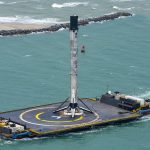Last week the Indian Space Research Organization (ISRO) put a record 104 satellites into orbit with a single launch, and now it’s preparing to launch Geosynchronous Satellite Launch Vehicle Mark III (GSLV Mark-III) in a few months.
India’s Polar Satellite Launch Vehicle, in its thirty-ninth flight (PSLV-C37), launched the 714 kilogram Cartosat-2 series satellite for earth observation and 103 co-passenger satellites together weighing about 663 kilograms at lift-off into a 505-kilometer polar Sun Synchronous Orbit (SSO).
Last week the Indian Space Research Organization (ISRO) put a record 104 satellites into orbit with a single launch, and now it’s preparing to launch Geosynchronous Satellite Launch Vehicle Mark III (GSLV Mark-III) in a few months.
India’s Polar Satellite Launch Vehicle, in its thirty-ninth flight (PSLV-C37), launched the 714 kilogram Cartosat-2 series satellite for earth observation and 103 co-passenger satellites together weighing about 663 kilograms at lift-off into a 505-kilometer polar Sun Synchronous Orbit (SSO).
PSLV-C37 was launched from the First Launch Pad (FLP) of Satish Dhawan Space Centre (SDSC) SHAR, Sriharikota on February 15, 2017. This was the sixteenth flight of PSLV in ‘XL’ configuration (with the use of solid strap-on motors).
The co-passenger satellites comprised of 101 Nano satellites, one each from Kazakhstan, Israel, The Netherlands, Switzerland, United Arab Emirates (UAE) and 96 from the United States, as well as two Nano satellites from India. The total weight of all these satellites carried on-board PSLV-C37 was about 1,377 kilograms.
PSLV-C37 also carried two ISRO Nano satellites (INS-1A and INS-1B), as co-passenger satellites. These two satellites carry a total of four different payloads from Space Applications Centre (SAC) and Laboratory for Electro Optics Systems (LEOS) of ISRO for conducting various experiments.
The 101 International customer Nano satellites were launched as part of the commercial arrangements between Antrix Corporation Limited (Antrix), a Government of India company under Department of Space (DOS), the commercial arm of ISRO and the International customers.
According to Phys.org, a web-based science, research and technology news service, celebrations erupted among scientists at the southern spaceport of Sriharikota as the head of the ISRO announced all the satellites had been ejected as planned.
"My hearty congratulations to the ISRO team for this success," the agency’s director Kiran Kumar told those gathered in an observatory to track the progress of the PSLV.
Prime Minister Narendra Modi congratulated the scientists for achieving the feat which broke a record previously held by Russia’s space agency, which launched 37 satellites into orbit with one rocket in 2014.
"They have hit a century in space technology," Modi said at an election rally in northern Uttar Pradesh state.
Many of the people celebrating the recorded declared it a “century,” a term for a cricketing milestone when a single batsman manages to score 100 runs in a single innings.
The rocket took off at 9:28 am (0358 GMT) and cruised at a speed of 27,000 kilometers (16,777 miles) per hour, ejecting all the 104 satellites into orbit in around 30 minutes, according to the ISRO.
After putting the record 104 satellites into orbit with a single launch, the ISRO is now preparing to launch GSLV Mark-III within a matter of months, according to an article published by The Economic Times, an English-language Indian daily newspaper
Former ISRO chairman G Madhavan Nair revealed the GSLV news while delivering the inaugural address at the 3rd ORF-Kalpana Chawla Annual Space Policy Dialogue organized by key think tank Observer Research Foundation, February 16-18 in New Delhi.
Nair, was also the president of the International Academy of Astronautics, suggested setting up an Integrated Space Development Agency for helping build civil aviation vehicles. He added that the country is proud of the ISRO for making significant progress and delivering on schedule.
“If we can do so well in rockets and satellites, why not in the aviation sector?” he asked, adding that that he was sure that India will be able to build aviation vehicles, provided there is political will and determination. “ISRO has once again done a great job. I am proud to stand before you today, a day after it put a record 104 satellites into orbit with a single launch,” Nair said, adding India would be launching GSLV Mark-III in few months.
To read about India’s completion of the IRNSS constellation last year, click here.




